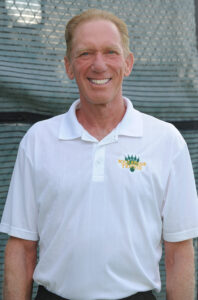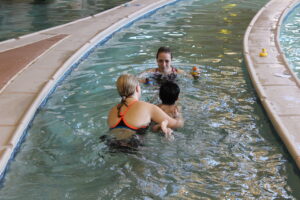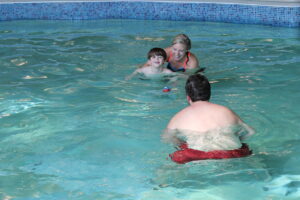Growing up in Bolivar, Mo., Landon Kirlin has had experience with people with mental health and special needs for all his life. Being raised with family members, friends and classmates with special needs, he has known he wanted work in the field for a long time. However, Kirlin has had a longer journey than some to arrive as a master’s student at the Thompson Center.
Kirlin first attended the University of Missouri as an undergraduate student, earning degrees in psychology and sociology. After graduating, he first learned about the Thompson Center when he began working in a 
“One of the men I worked with and supported had a position working at the Thompson Center,” Kirlin said. “I recognized even then the amazing work being done at the Thompson Center and the support and environment they fostered for my client and so many others.”
Kirlin’s journey then took him to Springfield, Mo., where he was introduced to Applied Behavior Analysis (ABA). In a position as a behavior technician, Kirlin learned more about both ABA and autism as he performed early intervention work for children on the spectrum.
“ABA really seemed to strike a chord for me,” Kirlin said. “I grew to appreciate the clarity it provides, how goal oriented and data driven it is. And most importantly how effective it can be in helping teach important skills and behaviors and how it can give families a sense of direction moving forward.”
For Kirlin, this work with ABA and with people with autism motivated him to expand his education and expertise of the practice. In 2018, Kirlin enrolled in the ABA master’s degree program at the University of Missouri College of Education and the Thompson Center. As a part of his studies, Kirlin will gain on-the-job training by working directly with people with autism at the Thompson Center.
“The opportunity to work and learn directly with patients was a huge draw for me to come to Mizzou and to the Thompson Center,” Kirlin said. “Having already had experiences with the Thompson Center and with Mizzou, I already knew it was an amazing place, so the choice was obvious and easy.”
Kirlin is on track to graduate with his master’s degree in the spring of 2020. Upon graduation, he hopes to continue his career in ABA by working on skill acquisition with older teenagers and adults with autism.
“ABA can be really effective in teaching social skills and reducing problem behaviors, so I look forward to using this knowledge to help others,” Kirlin said. “I enjoy this work so much because you really get back even more than you give. I come home each day and know that I’ve helped someone. It is a really great feeling.”
Kirlin also has a passion for music and hopes to incorporate that into his work in the future, sharing music and developing music-based programs for his patients. It’s this drive to learn and help patients that has earned Kirlin the second annual Davis Family Scholarship at the Thompson Center.
The Davis Family Scholarship provides annual support to a student at Mizzou who is currently training at the Thompson Center and pursuing a degree in an autism-related field. The selection process and criteria for awarding the scholarship is based on the recipient’s potential career impact on individuals and families with Autism Spectrum Disorder in the area(s) of advocacy; diagnosis and identification; research; and/or treatment and intervention. Criteria that Kirlin surpasses at every turn.
“I am so grateful for this scholarship,” Kirlin said. “I want to thank the Davises for this amazing opportunity and the support for my studies. I plan on paying it forward to my patients in the future.”
A future that is undoubtedly bright for Kirlin and his patients.

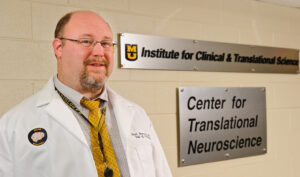 the Thompson Center and co-investigator for the Thompson Center site along with Dr. Kristin Sohl. “By helping recruit participants among our patient base, we can further study whether Clarifi ASD could play a role in helping identify children with autism early and easily.”
the Thompson Center and co-investigator for the Thompson Center site along with Dr. Kristin Sohl. “By helping recruit participants among our patient base, we can further study whether Clarifi ASD could play a role in helping identify children with autism early and easily.” with peers. However, it often is unclear how neurodevelopmental disorders such as autism effect how these changes manifest themselves socially.
with peers. However, it often is unclear how neurodevelopmental disorders such as autism effect how these changes manifest themselves socially.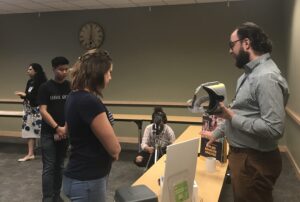 campus. This access, along with a tradition of fostering an atmosphere of collaboration across disciplines, has made the Thompson Center of a model of interdisciplinary work at Mizzou.
campus. This access, along with a tradition of fostering an atmosphere of collaboration across disciplines, has made the Thompson Center of a model of interdisciplinary work at Mizzou.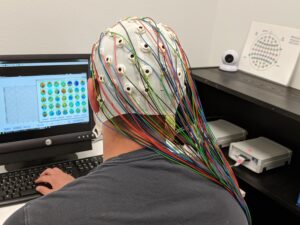 improving social communication using pharmaceuticals has, to this point, had limited results, depending on the specific drug and the specific patient.
improving social communication using pharmaceuticals has, to this point, had limited results, depending on the specific drug and the specific patient.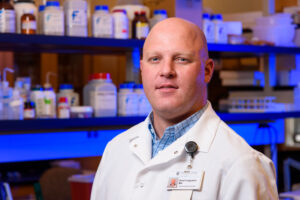
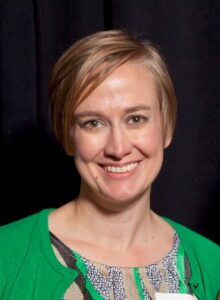 from Texas State University. She then pursued a doctorate in public health at Saint Louis University. She served as an Applied Behavior Analysis therapist in college and managed the Metro St. Louis HIV Health Service Planning Council prior joining the Department of Health Sciences at Mizzou in 2009. She has been performing research with the Thompson Center since shortly after starting at Mizzou in 2009.
from Texas State University. She then pursued a doctorate in public health at Saint Louis University. She served as an Applied Behavior Analysis therapist in college and managed the Metro St. Louis HIV Health Service Planning Council prior joining the Department of Health Sciences at Mizzou in 2009. She has been performing research with the Thompson Center since shortly after starting at Mizzou in 2009.